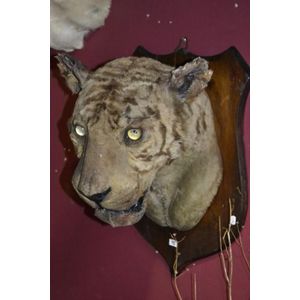Ebonised Faux Bamboo Armchair from Handbury Collection
You must be a subscriber, and be logged in to view price and dealer details.
Subscribe Now to view actual auction price for this item
When you subscribe, you have the option of setting the currency in which to display prices to $Au, $US, $NZ or Stg.
- Faux - A French word meaning "false", but when used in decorative arts, the intention is not to deceive, but to simulate the decorative effects of the more expensive material it is imitating. The term " faux bois" meaning "false wood" refers to a furniture item that has been decorated with a marked grain (woodgrain finish) to imitate a more expensive timber.
- Faux Bamboo - Faux in French means "artificial" or "imitation", so faux bamboo is imitation bamboo. The wood was turned, notched and painted to look like bamboo. It was a popular design feature in the Regency period and can be seen on many "Chinese Chippendale" pieces.
Influenced by the growing trade with China, the style reached its peak with the Prince Regent's Royal Pavilion at Brighton, designed by John Nash, and built between 1817 and 1822. - Ebonised - Timber that has been stained or lacquered black in imitation of ebony. The process has been used since the Renaissance, but is most commonly found in late 19th century furniture, sometimes gilded and turned in imitation of bamboo. Furniture with an ebonised finish is not currently in vogue, and this is reflected in the price for such pieces.
- Provenance - A term used to describe the provable history of an antique or work of art, and thus an additional aid to verifying its authenticity. Provenance can have an inflating effect on the price of an item, particularly if the provenance relates to the early settlement of Australia, a famous person, or royalty. Less significant are previous sales of the item through an auction house or dealer.
- Empire Style - The Empire style was a version of neo-classicism popular from 1800 to 1830, coinciding with the rule of Napoleon I from 1840-15. In England the style corrosponds with the Regency style and in the United States to the Federal style.
The style is inspired by classical Rome and Greece, as reflected in the decorative motifs in the the design such as paterae, guilloches, acanthus and swags, and pieces are lavishly decorated with applied gilded decoration.
This item has been included into following indexes:
- chairs, singles / pairs / threes, style or period
- chairs, singles / pairs / threes, timber - faux bamboo 7
Visually similar items

Le Corbusier (French, 1887-1965), LC3 Outdoor Armchair, manufactured by Cassina, with white stretched polyester cushion supported by stainless steel base, height 62 cm width 99 cm depth 40 cm

Ernest Edwin Abbott (1888-1973) 'The Distant Range, etching, signed in pencil lower right, 18.5 cm x 28.5 cm

A Louis XV style rosewood late 19th century vitrine, with an inversed cornice banded with ormolu, above a serpentine shaped glazed door flanked by curved glazed sides above floral marquetry, supported on small cabriole legs with ormolu sabots 165 cm high,

Victorian taxidermy tiger shoulder mount on wooden shield with original teeth
